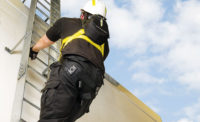Why these standards are important
Falls from portable ladders (step, straight, combination and extension) are one of the leading causes of occupational fatalities and injuries.
Hazards
Working on and around stairways and ladders is hazardous. Stairways and ladders are major sources of injuries and fatalities among construction workers for example, and many of the injuries are serious enough to require time off the job. OSHA rules apply to all stairways and ladders used in construction, alteration, repair, painting, decorating and demolition of worksites covered by OSHA's construction safety and health standards.
Enforcement Statistics
October 2015 through September 2016 – totals for construction
Citations: 2,392
Inspections: 1,967
Penalty: $4,470,537
#7 on OSHA’s Top 10 Most Frequently Cited Standards
Most Frequently Cited Provisions (construction)
- Each self-supporting portable ladder: At least four times the maximum intended load, except that each extra-heavy-duty type 1A metal or plastic ladder shall sustain at least 3.3 time the maximum intended load. The ability of a ladder to sustain the loads indicated in this paragraph shall be determined by applying or transmitting the requisite load to the ladder in a downward vertical direction. Ladders built and tested in conformance with the applicable provisions of appendix A of this subpart will be deemed to meet this requirement.
- The minimum clear distance between the sides of individual-rung/step ladders and the minimum clear distance between the side rails of other fixed ladders shall be 16 inches (41 cm).
- Fixed ladders without cages or wells shall have a clear width to the nearest permanent object of at least 15 inches (30 cm) on each side of the centerline of the ladder.
Most cited industries (construction)
- Specialty Trade Contractors
- Construction of Buildings
- Merchant Wholesalers, Durable Goods
- Heavy and Civil Engineering Construction
- Administrative and Support Services
- Miscellaneous Manufacturing
- Real Estate
- Repair and Maintenance
- Utilities
- Professional, Scientific, and Technical Services
What must employers do to protect employees?
1926.1053 specifies when employers must provide ladders. In general, the standards require the following:
- When there is a break in elevation of 19 inches or more and no ramp, runway, embankment or personnel hoist is available, employers must provide a stairway or ladder at all worker points of access.
- When there is only one point of access between levels, employers must keep it clear of obstacles to permit free passage by workers. If free passage becomes restricted, employers must provide a second point of access and ensure that workers use it.
- When there are more than two points of access between levels, employers must ensure that at least one point of access remains clear.
Compliance Assistance
Stairways and Ladders, a Guide to OSHA Rules, Publication 3124. This booklet published in 2003 provides a general overview of the standard and requirements.
OSHA Quick Card: Portable Ladder Safety. This informative tip sheet offers instructions on preventing falls from portable ladders.




